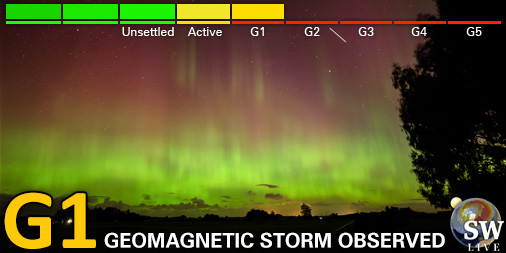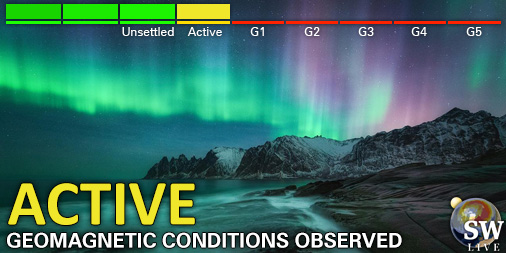Acronimi e abbreviazioni
Gli acronimi e le abbreviazioni sono molto comuni nei bollettini meteorologici spaziali e sono confusionari se non ci si è familiari. Su questa pagina troverete un elenco dei termini più comunemente usati con una breve descrizione.
| Breve | Intero | Descrizione |
|---|---|---|
| ACE | Advanced Composition Explorer | Veicolo di esplorazione solare e spaziale situato al punto Sole-Terra L1. Era la fonte principale di dati meteorologici spaziali in tempo reale fino al sopravvento di DSCOVR nel 2016. |
| AIA | Atmospheric Imaging Assembly | Strumento sul veicolo spaziale SDO. Fornisce osservazioni costanti del disco intero della cromosfera solare e della corona in sette canali ultravioletti estremi. |
| AR | Active Region | Gruppi di macchie solari indicati con un numero. Anche nota come regione di macchie solari. |
| BBSO | Big Bear Solar Observatory | Osservatorio solare situato negli USA e dotato di telescopi e strumenti usati specificamente per lo studio delle attività e dei fenomeni del Sole. |
| CCOR | Compact Coronagraph. | Instrument on the GOES satellite used to detect and study coronal mass ejections. |
| CH | Foro coronale | Area sul Sole dove le linee del campo magnetico si inarcano lontano dal Sole. Questo consente al vento solare di fuggire a un'alta velocità e di causare fori scuri nella corona come visto sulle immagini solari. |
| CIR | Co-rotating Interaction Region | Termine per il confine compresso tra il vento solare veloce e lento in un flusso di venti solari ad alta velocità da fori coronali persistenti su più rotazioni solari. |
| CME | Espulsione di massa coronale | Grande nuvola di plasma solare rilasciata nello spazio a causa di un evento sul Sole. |
| DSCOVR | Deep Space Climate Observatory | Un veicolo spaziale di osservazione terrestre e meteorologica spaziale operato dalla NOAA e situato al punto Sole-Terra L1. È la fonte principale dei dati IMF e sui venti solari in tempo reale. |
| DSF | Disappearing Solar Filament | La scomparsa del canale di un filamento solare spesso causata da un collasso o un'eruzione. |
| Dst | Disturbance storm time index | Indica la forza della corrente dell'anello intorno alla Terra, causata da protoni ed elettroni solari. Un valore Dst negativo significa che il campo magnetico della Terra è indebolito. Valori di -50nT e inferiori sono generalmente considerati come condizioni di tempesta geomagnetica. |
| EIT | Extreme ultraviolet Imaging Telescope | Strumento del veicolo spaziale SOHO. Fornisce immagini solari in quattro lunghezze d'onda differenti. |
| EPAM | Electron, Proton, and Alpha Monitor | Strumento del veicolo spaziale ACE. Misura un'ampia gamma di particelle energetiche. |
| ESA | European Space Agency | Organizzazione europea dedicata all'esplorazione dello spazio. |
| EUV | Extreme ultraviolet | Radiazione elettromagnetica da 124 nanometri a 10 nanometri nello spettro elettromagnetico. |
| EVE | Extreme Ultraviolet Variability Experiment | Pacchetto di strumenti sul veicolo spaziale SDO. |
| GFZ | GeoForschungsZentrum | Il Centro di Ricerca per la Geoscienza Tedesco GFZ è il centro di ricerca nazionale per le Scienze Terrestri in Germania. |
| GOES | Geostationary Operational Environmental Satellite | Serie di satelliti in un'orbita geostazionaria intorno alla Terra. |
| HSC | Heliospheric Current Sheet | Confine dove la polarità del campo magnetico del Sole cambia da nord a sud. La sua forma è comparabile alla gonna di una ballerina. |
| HF | High Frequency | Termine usato per descrivere le onde radio con una lunghezza d'onda tra 3 e 30 MHz. |
| HMI | Helioseismic and Magnetic Imager | Strumento sul veicolo spaziale SDO. |
| HSS | High Speed Stream | Flusso di venti solari a una velocità superiore alla media. Spesso usato per definire i venti solari provenienti da un foro coronale. |
| IMF | Campo Magnetico Interplanetario | Campo magnetico solare trasportaro dal vento solare tra i pianeti del Sistema Solare. |
| IRIS | Interface Region Imaging Spectrograph | Veicolo spaziale di osservazione solare della NASA. |
| L1 | Lagrangian point 1 | Punto nello spazio tra due oggetti velesti dove l'attrazione gracitazionale dai due oggetti è uguale. Diversi satelliti di meteorologia spaziale orbitano al punto Sole-Terra L1. |
| LASCO | Large Angle and Spectrometric Coronagraph | Strumento del veicolo spaziale SOHO usato per rilevare e studiare le espulsioni di massa coronale. |
| LMSAL | Lockheed Martin Solar and Astrophysics Laboratory | Parte del Lockheed Martin che progetta, costruisce e opera strumenti di osservazione solare e astrofisica. |
| MDI | Michelson Doppler Imager | Strumento del veicolo spaziale SOHO. Non è più in uso. |
| MLSO | Mauna Loa Solar Observatory | Un osservatorio solare situato sull'isola di Hawaii negli Stati Uniti d'America. |
| NASA | National Aeronautics and Space Administration | Agenzia americana responsabile del programma spaziale civile nonché di areonautica e ricerca aerospaziale. |
| NOAA | National Oceanic and Atmospheric Administration | Agenzia scientifica americana. Il Centro di Previsione SWPC è unitamente operato dalla NOAA e l'USAF. |
| nT | nanoTesla | Un'unità di misura della forza di un campo magnetico spesso usata in meteorologia spaziale. |
| PFU | Particle flux unit | Un'unità di intensità del flusso. Numero di particelle registrate al secondo, per centimetro quadrato e per steradiante. |
| PlasMag | Plasma Magnetometer Solar Weather Instrument | Tre strumenti sul veicolo spaziale DSCOVR che misurano il vento solare per le previsioni meteorologiche spaziali. |
| PROBA2 | PRoject for OnBoard Autonomy 2 | Veicolo spaziale dell'ESA che ha due strumenti scientifici per osservare il Sole. |
| SC | Solar Cycle | Periodo approssimativo di 11 anni di cambiamento dell'attività del Sole in cui cambia la polarità del campo magnetico del Sole su larga scala. |
| SDO | Solar Dynamics Observatory | Veicolo spaziale di osservazione solare operato dalla NASA in orbita geosincrona intorno alla Terra. |
| SI | Sudden Impulse | Un impulso improvviso si verifica quando un'espulsione di massa coronale dal Sole collide con la magnetosfera della Terra. Questo causa l'aumento della corrente dell'anello e del componente orizzontale del campo magnetico. Questo aumento appare come un picco improvviso sui magnetometri terrestri. |
| SIDC | Solar Influences Data Analysis Center | Fornitore di servizi di meteorologia spaziale europea situato in Belgio. |
| SIR | Stream Interaction Region | Termine per il confine compresso tra venti solari veloci e lenti in un flusso di venti solari ad alta velocità. |
| SOHO | Solar and Heliospheric Observatory | Veicolo di osservazione solare al punto Sole-Terra L1. |
| SPE | Solar proton event | Anche noto come tempesta di protoni. Se l'intensità dei protoni aventi un'energia di almeno 10 MeV è ad almeno 10 pfu ad altitudini geosincrone, allora è categorizzata come un SPE. |
| SSBC | Solar Sector Boundary Crossing | Attraversamento della Corrente Eliosferica risultante in un cambiamento nell'orientamento del campo magnetico del vento solare. |
| SSC | Storm Sudden Commencement | Un brusco cambiamento nel componente a nord (X) del campo geomagnetico. Segna l'inizio di una tempesta geomagnetica. |
| SSN | Smoothed Sunspot Number | Numero medio di macchie solari su un periodo specifico. |
| STA | STEREO Ahead | Veicolo spaziale di osservazione solare operato dalla NASA in un'orbita intorno al Sole. Orbita lievemente più velocemente intorno al Sole rispetto alla Terra. |
| STB | STEREO Behind | Veicolo spaziale di osservazione solare operato dalla NASA in un'orbita intorno al Sole. Orbita lievemente più lentamente intorno al Sole rispetto alla Terra. |
| SUVI | Solar Ultraviolet Imager | Strumento sul satellite GOES-16. Questo strumento osserva il Sole in sei lunghezze d'onda differenti in ultravioletto estremo. |
| SWPC | Space Weather Prediction Center | Centro di servizi che monitora continuamente e prevede l'ambiente spaziale della Terra. È la fonte ufficiale degli avvisi meteorologici spaziali e delle allerte per gli Stati Uniti. |
| USAF | United States Air Force | Branca di servizio delle Forze Armate degli Stati Uniti. Il Centro di Previsione della SWPC è operato unitamente dalla NOAA e dall'USAF. |
| UTC | Coordinated Universal Time | Standard orario principale su cui il mondo regola orologi e ora. |
| VHF | Very High Frequency | Termine usato per descrivere le onde radio con una lunghezza d'onda tra 30 e 300 MHz. |
| VLF | Very Low Frequency | Termine usato per descrivere le onde radio con una lunghezza d'onda tra 3 e 30 kHz. |
| XRS | Solar X-ray Sensor | Strumento sui satelliti GOES usato per misurare l'emissione di raggi X del Sole. |
| Å | Ångström | Unità di lunghezza comunemente usata per le lunghezze d'onda della radiazione elettromagnetica. 1 Ångström equivale a 10-10 metri, 0.1 nanometri o 100 picometri. |
I dati attuali suggeriscono ci sia una lieve possibilità perché l'aurora compaia alle seguenti regioni ad alta altitudine nel futuro prossimo
NuukTórshavn
Oulu, Rovaniemi
Reykjavik
Trondheim
Kiruna, Luleå
Ultime notizie
Ultimi messaggi dal forum
Supporta SpaceWeatherLive.com!
Molte persone vengono su SpaceWeatherLive per seguire l'attività del Sole o sapere se ci sia la possibilità di vedere l'aurora, ma a maggior traffico corrispondono costi maggiori. Considerate una donazione se vi piace SpaceWeatherLive così che possiamo mantenere online il sito web!

Ultimi avvisi
00:15 UTC - Attività geomagnetica
Tempesta geomagnetica G1 minore (Kp5) Soglia Raggiunta: 23:59 UTC
giovedì, 3 aprile PM
20:15 UTC - Attività geomagnetica
Tempesta geomagnetica G1 minore (Kp5) Soglia Raggiunta: 20:02 UTC
13:03 UTC - Indice di potenza emisferica
Il modello OVATION prevede che l'indice di potenza emisferica raggiunga i 50GW alle 13:56 UTC
mercoledì, 2 aprile AM
04:03 UTC - Indice di potenza emisferica
Il modello OVATION prevede che l'indice di potenza emisferica raggiunga i 50GW alle 04:56 UTC
01:45 UTC - Attività geomagnetica
Condizioni geomagnetiche attive (Kp4) Soglia Raggiunta: 01:32 UTC
Notizie sul meteo spaziale
| Ultimo brillamento X | 2025/03/28 | X1.1 |
| Ultimo brillamento M | 2025/04/01 | M2.5 |
| Ultima tempesta geomagnetica | 2025/03/27 | Kp5 (G1) |
| Giorni senza macchie | |
|---|---|
| Ultimo giorno senza macchie | 2022/06/08 |
| Media mensile Numero di Macchie Solari | |
|---|---|
| febbraio 2025 | 154.6 +17.6 |
| aprile 2025 | 152.5 -2.1 |
| Ultimi 30 giorni | 130.6 -15.9 |





